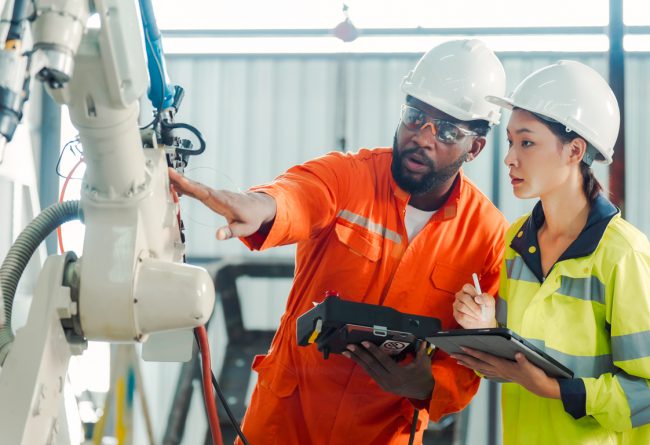Robotic Technology to Improve Government Workplace Safety

The Importance of Increasing Workplace Safety
Despite concerted efforts to reduce serious injury and death on the job, workplace fatality rates in the United States have remained unchanged over the past three decades. Though efforts have continued to improve workplace safety, including the adoption of the Occupational Safety and Health Act, scheduled workplace inspections, and even public outreach campaigns, serious injuries and fatalities continue to occur in the American workplace. Adopting the use of robotics and automation in the American workplace is improving workplace safety by reducing the risk of accidents and injuries for human workers.
What is robotics?
Workplace robotics involves using machines and automated systems to perform tasks, often with human workers overseeing or working alongside them to enhance efficiency and safety. Robotic technologies can replace human workers when tasks are hazardous, and safety concerns override the need to use humans.
Robots can be used to replicate human action by machine, such as on an assembly line for heavy lifting or repetitive motions that could lead to workplace accidents. Drones and robotics provide humans with new ways to view situations and environments, from hard-to-reach terrain to hazardous situations. They can also collect information that would normally expose humans to safety risks. Robotic technologies can also communicate with each other and with humans via online technology. Workers can then analyze this information as part of their decision-making processes.
Government employers are turning to robotic technology ushering in a new era of improved safety for workers. Creating a safer workplace shields governmental departments and organizations from potential setbacks, such as incident shutdowns, investigations, and fines.
National Safety Council Work to Zero Initiative
Workplace safety has been a priority in the United States for more than a century. The National Safety Council (NSC) was founded in 1913 to identify, address, and solve workplace safety issues. The NSC committed to eliminating workplace fatalities by 2050 by integrating emerging technologies. This effort is known as the Work to Zero Initiative.
A group of Environmental Health and Safety experts from industry, academia, government, and other leaders lead the Work to Zero Initiative. Robotics is one of the identified areas where Work to Zero is impacting workplace safety, especially in reducing workplace fatalities. Work to Zero has found that robotics benefit workplace health and safety in five key areas:
- Reducing physical risks, such as falling from heights, lifting, and entering confined spaces, by replacing these human tasks with robotic counterparts.
- Reduce the risk of musculoskeletal disorders (MSDs) from performing repetitive movements and heavy lifting by deploying robotics for these tasks.
- Reducing exposure to hazardous substances and environments using remote control or autonomous robotics.
- Reducing workplace injuries due to worker fatigue, associated with an increased risk of injury, by introducing robotics, which does not require breaks from activities.
- Improving worker satisfaction and health by reducing serious injuries and fatalities and improving productivity and working conditions.
Robotics Use Cases for Improving Workplace Health and Safety
There are several areas where robotics is already integrated into governmental workspaces and task areas. The most known are in support of federal or military missions, such as space missions, bomb disposal units, and even the “ghost dogs” that patrol some military bases. Robotics have also been integrated into the VA pharmacy system for nearly 40 years to help with prescription dispensing. This system has become more sophisticated as robotics and technology, such as the internet developed. With the system, dispensing drugs to the more than 9 million enrollees in the VA system.
The United States Post Office has tested various robotic sorting options in its facilities for several decades. More recent integrations have focused on autonomous mobile robots (AMR) that integrate sensors and navigation technology to move around facilities, which has helped reduce employee processing times and work hours. Robotic sorting technology also continues to help get nearly 129 billion pieces of mail to its recipients each year.
The Department of Labor has integrated Artificial Intelligence (AI) applications to assist Americans through various tools, including the long-term deployment of the Benefits.gov chatbot, which has answered questions about benefit plans from more than 200 million inquiries.
The Occupational Safety and Health Administration division uses HoloLens, a mixed-reality platform, to visually inspect high-hazard and unsafe areas that often-put human inspectors at risk.
The Benefits of Leveraging Robots in the Workplace
Leveraging robotic technologies in government workspaces offers several benefits, including:
- Enhanced Efficiency: Robots can perform repetitive and labor-intensive tasks quickly and accurately, allowing workers to focus on more complex and value-added responsibilities.
- Improved Safety: Robots can handle hazardous or dangerous tasks, reducing the risk of worker injuries and enhancing workplace safety.
- Cost Savings: Automation can lead to cost savings in the long run by reducing the need for extensive manual labor and streamlining operations.
- Increased Productivity: Robots can work around the clock or when workers are unavailable, leading to increased productivity and faster project completion times.
- Data Accuracy and Consistency: Robotic systems can collect and process data with high precision, reducing the likelihood of errors in government processes and decision-making.
- Better Resource Allocation: Government agencies can allocate their human resources to more strategic and complex functions by automating specific tasks and optimizing workforce utilization.
- Energy Efficiency: Some robotic technologies are energy-efficient and can contribute to reduced environmental impact by conserving resources and reducing waste.
Safety Concerns
Rapid advancements in robotics technology mean an increasing presence of robots in workplaces. These robots are not limited to traditional industrial settings. They can now work alongside human employees, performing a wide range of tasks, from inspecting offshore oil rigs and assisting healthcare workers in patient care to improving productivity in office settings.
While robots significantly improve worker safety by handling hazardous tasks, safety concerns are associated with their use, particularly in close human-robot interaction scenarios.
The safety concerns primarily revolve around the lack of comprehensive data on robot-related injuries and their specific details, particularly concerning newer robotics technologies. Understanding the risks associated with human-robot interaction and potential distractions posed by robots like drones is crucial for informing policy changes and actions to enhance worker safety and health in these evolving work environments.
To address these safety concerns, the CDC’s Center for Occupational Robotics Research, part of the National Institute for Occupational Safety and Health, is evaluating the potential of robotics technologies in preventing worker injuries and musculoskeletal disorders, understanding human-robot interactions, tracking injuries related to robotics technologies, and providing guidance on safe practices when working with robots.
Workplace safety training is important to keeping employees from harm, especially when new robotic integrations are added. Workplace safety coursework can help upskill your team and act as a refresher for essential workplace safety concepts.
For over 25 years, Enterprise Training Solutions has offered a broad range of course topics to align with your needs. Visit our Workplace Safety course descriptions to find out more.


